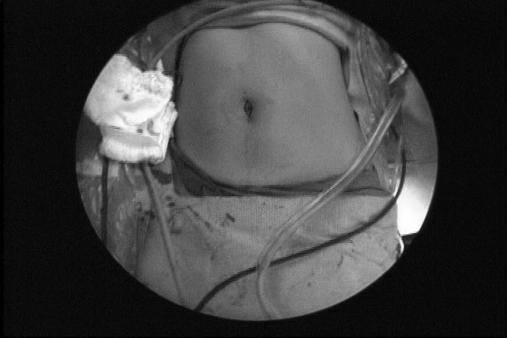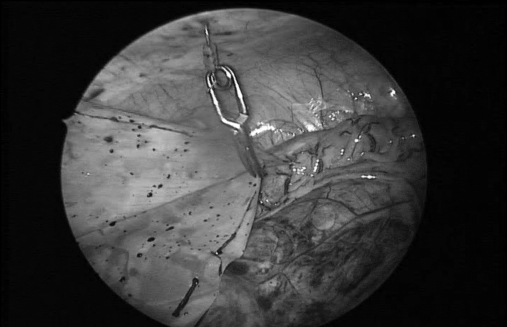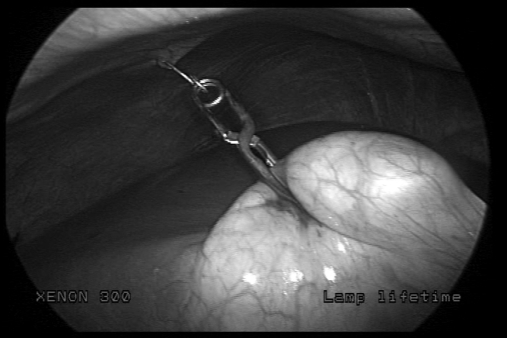LESS splenectomy appears to be a feasible procedure that can be performed safely and may have higher patient satisfaction that conventional laparoscopic splenectomy.
Keywords: Splenectomy, Laparoendoscopic single site surgery (LESS), Single site surgery
Abstract
Background and Objectives:
We present 2 cases of laparoendoscopic single site surgery (LESS) splenectomy performed with a conventional laparoscope and instruments, and the use of a novel internal retraction device.
Methods:
One patient underwent LESS splenectomy for idiopathic thrombocytopenia purpura (ITP), and a pediatric patient with sickle cell disease underwent LESS splenectomy and cholecystectomy. In each case, a 2-cm vertical incision was made within the confines of the umbilical ring, and a SILS port (Covidien, Norwalk CT) inserted. A 5-mm, 30-degree laparoscope and standard 5-mm instruments were used. After isolation of the splenic hilum, one 5-mm trocar of the SILS port was upsized to 12mm, and a laparoscopic stapler was used to divide the splenic artery and vein. An internal retractor consisting of a laparoscopic bulldog clamp with a hook attachment was used to retract the gallbladder, and to secure the specimen retrieval bag during splenic extraction, which eliminated the need for a fourth trocar.
Results:
Total operative time was 160 minutes for the LESS splenectomy, and 216 minutes for the LESS splenectomy and cholecystectomy. Both procedures were successfully completed with conventional instrumentation and a SILS port, without the need for additional incisions or trocars. No complications occurred, and both patients had an uneventful recovery.
Conclusions:
LESS splenectomy is a feasible procedure that can be performed safely. Although articulating instruments and laparoscopes may offer advantages, they are not necessary for performing LESS splenectomy.
INTRODUCTION
Laparoendoscopic single site surgery (LESS) is a promising alternative to conventional laparoscopic surgery and has redirected attention from natural orifice transluminal endoscopic surgery (NOTES). Its popularity has led to the development of novel instruments and techniques to facilitate LESS procedures, which may offer advantages, but are not absolutely necessary.1–4 LESS operations have been reported for urological, gastrointestinal, gynecologic, and endocrine procedures.5–8 For general surgical procedures, LESS cholecystectomy and appendectomy have been increasingly reported, with only several published reports of LESS splenectomy. We present 2 cases of LESS splenectomy performed with a conventional laparoscope and instruments, and the use of a novel internal retraction device.
CASE REPORTS
A 25-year-old female with a longstanding history of idiopathic thrombocytopenia purpura (ITP) presented with spontaneous gingival bleeding and hemotympanum. Her initial platelet count was 3000 which increased to 75 000 with prednisone and intravenous gamma globulin. The patient was referred for minimally invasive splenectomy. Triple vaccination was administered in preparation for surgery.
The second patient was a 17-year-old female with sickle cell disease, who presented with left upper quadrant and right upper quadrant pain. She had an enlarged spleen measuring 15.4cm on ultrasound, and multiple large gallstones. After triple vaccination, she underwent simultaneous LESS splenectomy and cholecystectomy.
Operative Technique
Patients were placed in the right lateral decubitus position. The umbilicus was everted, and a 2-cm vertical incision was made within the confines of the umbilical ring. The midline fascia was divided and a SILS port (Covidien, Norwalk CT) inserted. A 5-mm, 30-degree laparoscope was used throughout the procedure along with standard 5-mm instruments (Figure 1). Dissection progressed in a lateral to medial approach, with the splenic ligaments and short gastric vessels divided using a Harmonic scalpel. A complete exploration for accessory splenic tissue was performed, which revealed a 2-cm splenule, which was removed. After the splenic hilum was completely isolated, a 5-mm trocar within the SILS port was upsized to 12mm, and a laparoscopic stapler was used to divide the splenic artery and vein.
Figure 1.
External view of umbilical incision.
A nylon specimen bag was used for splenic extraction, with a modified bulldog clamp and hook used to secure one edge of the bag to the abdominal wall (Figure 2). This avoided the need for a fourth trocar and instrument. The spleen was carefully morcellated within the bag to avoid spillage and potential splenic implantation. Total operative time was 160 minutes. The patient was discharged the following day, and was well recovered at 2-week and 2-month follow-ups.
Figure 2.
Intracorporeal retractor used to secure specimen bag.
The second patient underwent LESS splenectomy and cholecystectomy with an operative time of 216 minutes. After the splenectomy was completed, the patient was moved to a supine, split-leg position for the cholecystectomy. To retract the gallbladder fundus cephalad, the modified bulldog clamp was again used as an internal retractor. The clamp portion was applied to the gallbladder wall, and the attached hook secured to the abdominal wall. She was discharged on the second postoperative day, and was well recovered at the follow-up visit.
DISCUSSION
Laparoscopic splenectomy was first described in 1992, and is now well established for the treatment of multiple hematologic diseases, primary splenic tumors, and metastatic disease involving the spleen.9–11 Even more so than appendectomy, laparoscopic splenectomy decreases length of stay and recovery compared to an open procedure.12,13
LESS procedures are still in evolution, and the majority of published literature describes cholecystectomy and appendectomy. Our initial experience with LESS also began with cholecystectomy and appendectomy, and after 25 such procedures, we embarked on a LESS splenectomy. While we performed LESS cholecystectomy and appendectomy with low-profile 5-mm trocars, we elected to use a single port access device (SILS port) for our LESS splenectomy, primarily to facilitate exchange between a 5-mm and 12-mm trocar, which would be necessary for a laparoscopic stapler to secure the splenic hilum. Another consideration was to minimize air leakage around individual 5-mm trocars, which can develop during lengthier cases, and repetitive torque on the trocars leads to enlargement of the fascial opening. The SILS port creates a tighter fascial seal to prevent air leakage.
In the pediatric population, Dutta14 successfully performed multiple LESS procedures including splenectomy. His technique uses articulating instruments (Realhand High Dexterity Instruments, Novare Surgical, Cupertino, CA), with comparable outcomes to those of standard laparoscopic surgery. Another report of LESS splenectomy by Targarona et al15 incorporated a flexible laparoscope and flexible instruments. This equipment is not readily available to many centers due to cost constraints, and we chose to develop a technique where additional instrumentation was kept to a minimum. Rottman et al16 described LESS splenectomy using 5-mm trocars and conventional instruments within an umbilical incision.
In our cases, an intracorporeal retractor was used to anchor the specimen bag to the abdominal wall and also to retract the gallbladder, which avoided the need for a fourth trocar. This retractor is easily made by attaching a small metal hook to a laparoscopic bulldog clamp. An alternative technique is the use of extracorporeal sutures passed through the abdominal wall, which we used for LESS cholecystectomy in our earlier experience. We have found that either technique is an effective substitute for a fourth trocar and instrument.
CONCLUSION
LESS splenectomy is a feasible procedure that can be performed safely and may lead to higher patient satisfaction compared to laparoscopic splenectomy by avoiding multiple incisions (Figure 3). Operative time is clearly increased with LESS splenectomy compared to laparoscopic splenectomy, but as the learning curve improves, this will likely decrease. While articulating instruments and laparoscopes may offer technical advantages, they are not necessary for performing LESS splenectomy. Comparative studies will be necessary to demonstrate whether LESS splenectomy confers other benefits, such as decreased pain and faster recovery, compared to laparoscopic splenectomy.
Figure 3.
Intracorporeal retractor used to retract gallbladder fundus.
Contributor Information
Modesto J. Colon, Division of General Surgery, Department of Surgery, Mount Sinai School of Medicine, New York, New York, USA.
Dana Telem, Division of General Surgery, Department of Surgery, Mount Sinai School of Medicine, New York, New York, USA.
Edward Chan, Division of General Surgery, Department of Surgery, Mount Sinai School of Medicine, New York, New York, USA.
Peter Midulla, Division of Pediatric Surgery Department of Surgery, Mount Sinai School of Medicine, New York, New York, USA..
Celia Divino, Division of General Surgery, Department of Surgery, Mount Sinai School of Medicine, New York, New York, USA.
Edward H. Chin, Division of General Surgery, Department of Surgery, Mount Sinai School of Medicine, New York, New York, USA.
References:
- 1. Langwieler TE, Nimmesgern T, Back M. Single-port access in laparoscopic cholecystectomy. Surg Endosc. 2009; 23(5): 1138–1141 [DOI] [PubMed] [Google Scholar]
- 2. Chow A, Purkayastha S, Aziz O, et al. Single-incision laparoscopic surgery for cholecystectomy: an evolving technique. Surg Endosc. 2010; 24(3): 709–714 [DOI] [PubMed] [Google Scholar]
- 3. Hong TH, You YK, Lee KH. Transumbilical single-port laparoscopic cholecystectomy : scarless cholecystectomy. Surg Endosc. 2009; 23(6): 1393–1397 [DOI] [PubMed] [Google Scholar]
- 4. Rottman SJ, Podolsky ER, Kim E, Kern J, Curcillo PG. 2nd Single port access (SPA) splenectomy. JSLS. 2010; 14(1): 48–52 [DOI] [PMC free article] [PubMed] [Google Scholar]
- 5. White WM, Haber GP, Goel RK, et al. Single–port urological surgery: single–center experience with the first 100 cases. Urology. 2009; 74(4): 801–804 [DOI] [PubMed] [Google Scholar]
- 6. de la Torre RA, Satgunam S, Morales MP, et al. Transumbilical single-port laparoscopic adjustable gastric band placement with liver suture retractor. Obes Surg. 2009; 19(12): 1707–1710 [DOI] [PubMed] [Google Scholar]
- 7. Geisler DP, Condon ET, Remzi FH. Single incision laparoscopic total proctocolectomy with ileopouch anal anastomosis. Colorectal Dis. 2010. September; 12(9): 941–943 Epub 2009 Nov 6 [DOI] [PubMed] [Google Scholar]
- 8. Cindolo L, Gidaro S, Tamburro FR, et al. Laparo-endoscopic single-site left transperitoneal adrenalectomy. Eur Urol. 2010. May; 57(5): 911–914Epub 2009 Jul 10 [DOI] [PubMed] [Google Scholar]
- 9. Carroll BJ, Phillips EH, Semel CJ, et al. Laparoscopic splenectomy. Surg Endosc. 1992; 6(4): 183–185 [DOI] [PubMed] [Google Scholar]
- 10. Delaitre B, Maignien B. Laparoscopic splenectomy–technical aspects. Surg Endosc. 1992; 6(6): 305–308 [DOI] [PubMed] [Google Scholar]
- 11. Telem D, Chin EH, Colon M, et al. Minimally invasive surgery for splenic malignancies. Minerva Chir. 2008; 63(6): 529–540 [PubMed] [Google Scholar]
- 12. Gigot JF, Etienne J, Lengele B, et al. Elective laparoscopic splenectomy: personal experience and literature review. Semin Laparosc Surg. 1996; 3(1): 34–43 [DOI] [PubMed] [Google Scholar]
- 13. Gigot JF, Healy ML, Ferrant A, et al. Laparoscopic splenectomy for idiopathic thrombocytopenic purpura. Br J Surg. 1994; 81(8): 1171–1172 [DOI] [PubMed] [Google Scholar]
- 14. Dutta S. Early experience with single incision laparoscopic surgery: eliminating the scar from abdominal operations. J Pediatr Surg. 2009; 44(9): 1741–1745 [DOI] [PubMed] [Google Scholar]
- 15. Targarona EM, Pallares JL, Balague C, et al. Single incision approach for splenic diseases: a preliminary report on a series of 8 cases. Surg Endosc. 2010. September; 24(9): 2236–2240 Epub 2010 Feb 23 [DOI] [PubMed] [Google Scholar]
- 16. Rottman SJ, Podolosky ER, Kim E, Kern J, Curcillo PG. Singe port access (SPA) splenectomy. JSLS. 2010; 14(1): 48–52 [DOI] [PMC free article] [PubMed] [Google Scholar]





